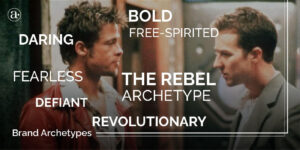Your strategy is the DNA and backbone that holds your brand together. It is about uncovering what makes your brand unique and putting together a plan to influence how your target customers feel about your product or brand. A brand positioning statement is an essential part of your overall strategy. So what is a positioning statement and how do you position your brand for success? Below are some examples of a positioning statement along with some frameworks to help you craft one for yourself.
What is brand positioning?
"The act of designing the company's offer and images so that it occupies a distinct and valued place in the target customer's minds."
~ Philip Kotler
The truth is that everyone remembers their first. The best way to have a uniquely valuable place in someones mind is to be first. Everyone remembers Neil Armstrong but most people don’t remember the 2nd or 3rd man on the moon. That is because our memory is very limited. In advertising, even though hundreds of people are selling the same kind of product, most people will only remember the top 3! Customers rank the different brands in their minds from #1 to a maximum of 7. The average person can’t even remember over 7 chunks of info so if your brand isn’t at least the 7th then it will be impossible to compete.
You can’t defeat brands that are already well established as #1 in peoples minds. #1 for sneakers will always be Nike and #1 for coffee will always be Starbucks unless these brands have a weakness or do something to tarnish their reputation. A much safer approach would be to create a new category or niche that your brand can own as #1. You can be #1 in a specific location or to a specific type of customer. You can also own a concept in people’s minds similar to how Apple revolves around ease of use, simplicity and thinking different.
Positioning is all about clarity
Positioning is all about clarity. It’s about looking into your industry to find a unique need that customers have that your brand can fulfill better than anyone else. This way you can uncover where your brand can fit in people’s minds, hearts and lives. You can’t begin advertising until you first position your brand for success!
A brand positioning statement is the foundation that determines where your brand fits in your customers mind as well as in your industry. It usually covers who the ideal customer is as well as the category that the brand falls into. It also covers the benefit and the reason to believe. It is used to inspire both your brands verbal messaging and visual expression. You can’t have a successful rebrand without a repositioning.
When do you need a brand positioning statement?
There are two main instances when you would need a positioning statement. The first is when you are launching a new brand, product or ad campaign. The second is if you are looking for a market opportunity or have found one already so need to execute a successful rebrand. Branding firms and consultants use tactics like market mapping and semantic differential to help clients uncover an opportunity to position a brand for success. Below are some simple frameworks to help you craft a compelling positioning statement for yourself.
Crafting a brand positioning statement
In order to craft an effective positioning statement you must first consider the ideal customer and what unique role the brand can play in his or her life. You must find a gap or category in the market where your brand fits. You must be clear about what makes your brand different, the end benefit the customer receives and the reason to believe. This all needs to be backed by research to inform your overall strategy. Here is a popular framework that is used to craft a positioning statement. It is made up of 5 parts:
1) Target: The identified customer profile based on research
2) Category: Where the brand fits in the customer’s mind
3) Point-of-Difference: The unique claim that the brand has
4) End Benefit: The benefit that this difference provides
5) Reason to Believe: the reason why people should believe
"For (target audience), (Brand) is the (category) that (point of difference) so they can (end benefit) because (reason to believe)."
Below is an example of a positioning statement
"For creative professionals with an eye for capturing and sharing beauty, Nixon is the digital point and shoot that delivers a window to the world so they can experience deeper connections through a shared perspective because of Nixon's 100 yr history of developing new technologies that allow you to capture and share your experience in their purest form. It's as if you were there."
The Onliness Statement
The onliness statement is a more modern approach to brand positioning. It was coined by branding expert, Marty Neumeier in his book, Zag. It is a statement that is made up of a 6 part framework: What category the brand fills, how you do it, who you do it for, where you serve, why people choose you and the current era when your brand is relevant.
What: What is the category that your brand uniquely fills
How: How do you do what you do?
Who: Who do you do it for?(Target customers)
Where: What is the target location that you serve?
Why: Why do people choose you?
When: What is the era or underlying trend that makes your brand relevant?
Below is an example of an onliness statement:
“Harley Davidson is the only motorcycle manufacturer that makes loud big motorcycles for macho guys(and macho wannabees) mostly in the united states who want to join a gang of cowboys in an era of decreasing personal freedom”
7 Successful Examples of Brand Positioning
1.) Volkswagen was first to own the “small-car” positioning. They leveraged it with the “Think Small” campaign.
2.) Milk Duds positioned itself as the long-lasting alternative to candy bars.
3.) 7UP Positioned itself as “The Uncola” drink to compete with Coca Cola and other colas on the market.
4.) Nyquil was the first to position itself as the night-time cold remedy.
5.) Marlboro was the first to establish a masculine positioning for cigarettes. They leveraged it with the Marlboro Man Campaign.
6.) Avis positioned themselves as #2 after Hertz. They leveraged it with the “We Try Harder” Campaign. They may not be #1 but they try harder.
7.) Tesla was the first to own the “luxury electric vehicle” positioning.
In Conclusion
Your brand needs to stay relevant and have meaning in people’s hearts and lives. You need a strong reason why people should choose you over others who are offering something similar. In a highly competitive industry, where does your brand fit in? Do you have a clear positioning? Are people clear about where your brand fits?
If you are serious about taking your brand to the next level then you definitely need a strategy. This strategy needs to be expressed consistently through your brand messaging and design in a way that is clear and concise. Do people know, like and trust your brand? Do they understand why they should buy from you instead of others? Is your brand message aligned with the target audience? If you enjoyed this article then you may also enjoy my previous one on 5 reasons why your company may need a rebrand.
To learn more about positioning you can read:
“Positioning: The battle For Your Mind” By Al Reis and Jack Trout.
“Creative Strategy and The Business Of Design” by Douglas Davis







2 Responses
Excerpts from my book on Positioning, “The Position Player” by Tom McManimon
You cannot effectively carve out a strong brand position until you find a unique place to shine. This is your best position to compete to win—to win the hearts, minds, wallets and loyalty of customers. You can practice your skill with focus and determination. You can have a breakthrough product. You can even offer an innovative service. But what will truly elevate you and distinguish you from your competition is knowing the strengths, weaknesses and tendencies—yours and your competitors’. Learning these things—through observation and/or market research—can help you strategize a marketing approach that highlights your strengths—giving you your best chance for success.
“All brands who position themselves successfully do one thing very well. They buy a piece of land for their brand, and build something unique. “The real estate analogy is fitting because, when you buy land, no one else can build on that land. It’s yours. You paid for it. You have the deed. And, like real estate, you own what’s above it and what’s below it. “But unlike real estate, there’s no law that says how big your building can be. Or how high it can go. Very exciting indeed. “Some marketers, though, in their infinite shrewdness, will try to buy property next to your land. And hope that, to a consumer, what they’re building is similar to what you’re building. And maybe it’s even a little cheaper. “Well, that’s when you have to start building something else. “Equity.“
Thanks for your contribution. Brand positioning must always be done through a solid understanding of the market landscape.